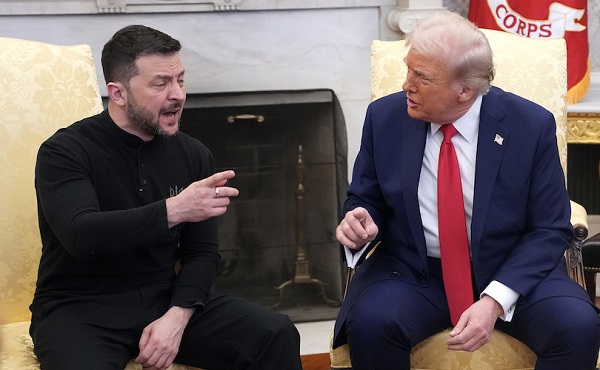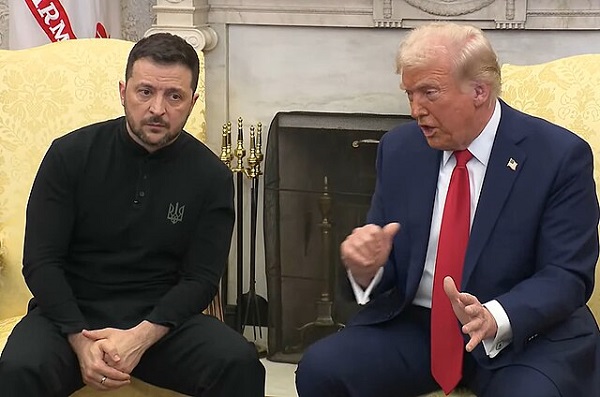conflict
Once Again, Biden Doesn’t Have A Strategy For Ukraine. Where’s The Money Going?

 From the Daily Caller News Foundation
From the Daily Caller News Foundation
The administration that claims to be “saving the soul of Democracy” has once again blown off the legislative branch of government.
When the law to give Ukraine another $61 billion made its way through Congress back in April, lawmakers appropriated the money with strings attached. One big string was section 504 of the bill, which stipulated that within 45 days, the administration had to present a strategy for the war. That strategy was due on June 4 — the Biden administration’s homework is now two months late.
You would be forgiven for thinking we formed a strategy before sending $175+ billion in American tax dollars to the plains of Eastern Europe. Two years into a war that has claimed a million lives, Congress asked for a plan that lays out “specific and achievable objectives” and prioritizes “United States national security interests.” Congress also reasonably requested a best guess on how our actions in Ukraine will be met by Russia, China, North Korea and Iran.
When the plan finally does arrive on lawmakers’ desks, expect a thousand pages of government pablum. Gone are the days when U.S. leaders clearly and concisely articulated reasons to go to war and our representatives voted on whether or not to commit the nation to conflict.
The United States hasn’t declared war since 1942. Every American knew the Roosevelt administration’s plans for the war on its first day — the president told Congress on December 8, 1941, that the U.S. would “win through to absolute victory” and make sure “this form of treachery shall never again endanger us.” Hard to believe now, but Roosevelt’s demanding “absolute victory” was controversial in that it meant the United States would need to conquer, not just defeat, the Empire of Japan and Third Reich.
Today, our leaders have stopped asking for the approval of the American people when it comes to conflict — ever since we rebranded the War Department, the Department of Defense has been much more war-like.
The war in Ukraine is the latest example. The American people have not been fully briefed on the risks of that far-away battle or the point of U.S. involvement. Our lame-duck president, when he addresses Ukraine at all, calls Russian President Vladimir Putin a “war criminal” and claims “we know Putin won’t stop at Ukraine.” That is the total depth of his argument, which he expects the American people to swallow without debate.
But the president’s invective does not make for sound strategy.
First, the risks. America is engaged in a proxy war with Russia, as evidenced by the Russian peoples’ belief that they are at war with the United States and the west. NATO’s expansion towards Moscow is a major red line for Russia. It is also a broken promise, as the United States pledged not to move NATO’s borders “one inch eastward” towards Moscow. After it moved 1,000 miles eastward, Vladimir Putin drew the line in 2007, saying NATO expansion “represents a serious provocation that reduces the level of mutual trust. And we have the right to ask: against whom is this expansion intended?”
The concern is one that has haunted Russian leaders for centuries. The Poles invaded Russia in 1605, the Swedes in 1707, the French in 1812, and the Germans in 1914 and 1941. In World War II alone, the Soviets lost 24 million people — an incomprehensible figure, dwarfing the 418,000 American casualties.
Regardless of what one thinks of Russia’s system of government or Vladimir Putin, it is a fact that in the past 500 years, Russia has often found itself the target of Western aggression. Perhaps when Putin threatens nuclear war over Ukraine, it is worth taking seriously.
Another risk is to our own vital stocks of armaments. Ukraine is blowing through American missiles and projectiles as an unsustainable rate. Consider that, according to the Congressional Research Service, we’ve given the Ukrainians “10,000+” Javelins and “2,000+” Stingers. That “+” is the classified fig leaf over the exact number, but it is safe to assume we are running low on these arms for our own defense. Until 2022, the United States had not purchased a Stinger since 2003 and the missile line was closed entirely in 2020. Even under the rosiest of scenarios, it is unlikely we will be able to replenish the Stingers we have given to Ukraine until 2028.
Lastly, the huge expenditure of taxpayer dollars going to Ukraine has totaled enough to double the U.S. Navy’s fleet. Worse, it is borrowed. The $175 billion is money we do not have, and that sum does not include interest on the debt.
Given the risks and money on the line, Congress should demand the Biden administration comply with the law. The American people deserve a full accounting.
Morgan Murphy is a former DoD press secretary, national security adviser in the U.S. Senate, a veteran of Afghanistan.
The views and opinions expressed in this commentary are those of the author and do not reflect the official position of the Daily Caller News Foundation.
Featured Image Credit: Official White House Photo by Adam Schultz
conflict
Why are the globalists so opposed to Trump’s efforts to make peace in Ukraine?

From LifeSiteNews
By Frank Wright
The narrative over Ukraine reveals not only how hard the war economy will fight to rescue its system from peace, but also how the hardest sell these days is hard reality.
The Trump administration’s moves toward peace in Ukraine – and elsewhere – have attracted widespread criticism from within and without the globalist establishment.
As the U.S. government now threatens to “walk away” from Ukraine if its seven-point peace plan is rejected, a new battle line is being drawn between permanent war and propaganda – and the urgent reality demanding radical change from the globalist business as usual.
Trump has proposed an immediate ceasefire, no NATO membership for Ukraine, and for Russia to keep the territories it has taken during the war – with the U.S. to recognize Crimea as Russian. The proposal for peace has been met with outrage, and even accusations of betrayal. Yet the peace deal appears to be a simple recognition of reality. What’s the problem?
Dan Davis’ deep dive into Ukraine
In his deep dive of April 23, Dan Davis helps to explain why reality is so controversial and the mention of peace akin to treason. He joins German journalist and academic Patrik Baab to show how the pro-war faction in the U.S. and Europe have fought their own line in the media for well over a decade.
Davis, whose appointment to a National Intelligence post was recently sabotaged by another war faction – that of the Israel lobby – has learned the personal consequences of contradicting the globalist war narrative. So has Baab – who was fired from his academic post in 2022 for the crime of journalism.
Baab had traveled to Donbass to research a now published book he discusses with Davis. Titled On Both Sides of the Front, it informs his discussion of the “NATO-backed Maidan coup” in 2014 and the media campaign which has sold this war to Westerners as yet another defence of democracy abroad – as in Iraq. According to Foreign Policy, Ukraine is a magical democracy which “still functions without elections.”
Having arrived at the time of the Russian-backed elections in Donetsk and Lugansk regions, Baab was accused on his return to Germany of having “legitimized” the votes and was dismissed and smeared in the German press.
Both Davis and Raab give important context to U.S. threats to “walk away” from Ukraine if a peace deal is not settled, showing the reason why “two different stories” are so often told “about the same events.”
Reality vs. fantasy, or life and death
In Western politics and media, one side is invested in the war and the other is not. This can also be seen as the factions of fantasy versus reality.
The globalist faction has told us the Russians were losing, that Putin was dying, that there would be “total victory” for Ukraine and no negotiations until Putin was toppled. Zelensky issued a decree forbidding negotiations with Russia.
EU Chief Commissioner Ursula von der Leyen famously claimed in 2022 that Russia was cannibalizing “refrigerators and washing machines” to harvest microchips for its war machine, with the UK defense minister saying in early 2023 that Russian soldiers had been reduced to fighting with shovels. In the media, Ukraine’s victory was only a matter of time – which was money. Yours.
To keep this money flowing, the Western audience whose taxes provide it must be convinced there is good reason to keep sending it to Zelensky, who cannot pay it back.
U.S./NATO started the war
As Baab explains, the reason why the global faction arranged this war was nothing to do with Ukraine – the objective was to collapse and balkanize Russia. This would give the globalist British state and its pro-war EU partners a new lease of geopolitical life, as well as shoring up their crippled economies with command of Russia’s near limitless natural resources.
A global war industry
Former U.S. Secretary of State Antony Blinken ran WestExec – a profitable war business consultancy, one of many which monetized forever war through influence peddling.
Former under-secretary of state Victoria Nuland, who managed the 2014 coup in Ukraine, has her own family business of war. It is called “the Kagan-industrial complex” after her husband arch-neocon Robert Kagan and his brother Frederick – whose ISW urges escalation in the talking points it supplies to pro-war outlets in the mainstream media. This network runs public relations for the wars its members start. Nice work if you can get it.
Russia has won
This is the reality behind the slogans of “Slava Ukraini” and the framing of the war as the defense – and inevitable triumph – of “democracy.” This fantasy narrative is now collapsing. Why?
In reality, Russia has won the war. As Baab points out, “Putin won the war. That means the West has to meet Putin’s proposals.”
This reality is a problem for the Western media which has sold every disastrous war of the last century as a win and a sacrifice in the defense of democracy. It is also a problem for the liberal-global elite, whose political capital is invested in the defeat of Russia.
U.S. will ‘walk away’ if no deal
U.S. Secretary of State Marco Rubio – together with Vice President JD Vance – have said that if Trump’s seven-point plan is not accepted the U.S. will “walk away” from Ukraine – as retired Colonel Douglas Macgregor has consistently said they should.
Neither Rubio nor chief negotiator Steve Witkoff attended the London conference on April 23, at which Zelensky predictably rejected Trump’s seven-point peace deal.
Col. Macgregor told Judge Andrew Napolitano it was clear “Zelensky is not going to agree” to the proposed deal.
Why? It is based on reality. Macgregor agrees that the U.S. should walk away – reminding viewers “this war would never have happened had we not mightily supported this regime we helped into power in 2014.”
Why did the U.S. do that? “To attack Russia,” Macgregor says, “because the whole idea was to build up a Ukrainian battering ram and hurl it at Russia. Crazy.”
A frustrated and uncharacteristically alarmed Macgregor asks, “Why are we even involved?”
He suggests “the best President Trump can do is say ‘It’s over. I never wanted this. It’s not my war. I’m suspending all aid, I’m pulling out.’”
The former Trump adviser adds, “Well, he didn’t do that. What’s next? I’m not sure.”
“Whatever happens, we look ridiculous. Again.”
Macgregor adds that “at least we have had the sense to walk away. What’s important is to normalize relations with Moscow,” explaining that Zelensky’s claims to Crimea and the Russian regions now absorbed into Russia are “nonsense.”
Trump: recognizing reality?
The Trump administration has offered to recognize Crimea as Russian – as has been historically and actually the case. Trump himself has accused Zelensky of sabotaging the peace deal, as the unelected leader of Ukraine refuses this and other concessions made unavoidable by the fact that Russia has won the war.
“The situation for Ukraine is dire – He can have Peace or, he can fight for another three years before losing the whole Country. I have nothing to do with Russia, but have much to do with wanting to save, on average, five thousand Russian and Ukrainian soldiers a week, who are dying for no reason whatsoever.”
Trump laid the blame squarely on Zelensky – saying his impossible demands would simply prolong the killing, as well as resulting in total defeat.
“The statement made by Zelenskyy today will do nothing but prolong the ‘killing field,’ and nobody wants that! We are very close to a deal, but the man with ‘no cards to play’ should now, finally, GET IT DONE.”
In 2014, Crimeans voted “overwhelmingly” to secede from Ukraine and rejoin Russia. The territory was gifted to the Ukrainian Soviet Republic by Nikitia Khrushchev in 1954, though its population remained predominantly ethnic Russian.
Trump’s aim, as Alastair Crooke has pointed out, is far bigger than merely ending this war. The overall goal here is a reset of the global order – away from the death cult model of forever war, and toward stabilization and trade abroad to power national renewal at home. As Crooke notes, Trump “is ringed by a resolute domestic enemy front in the form of an ‘industrial concern’ infused with Deep State ideology, centered primarily on preserving U.S. global power (rather than on mending of the economy).”
Surrender to Russia?
Reports in the globalist media of a total surrender to Russia are overblown:
Trump countered the narrative of “concessions” to Russia with the stark riposte that Russia’s choice not to “take all of Ukraine” was a significant concession in itself.
As Alex Christoforou of The Duran noted, Trump’s position on Crimea presented the EU with a “choice,” which the globalist Financial Times says was “forced” upon the pro-war bloc.
The EU had a choice, support US or Ukraine. EU chose Ukraine, and rejected Trump's plan for US recognition of Crimea.
The EU rejects the US decision to recognize Crimea.
“Crimea is Ukraine,” EU foreign policy chief Kaja Kallas told French news agency AFP.Via FT: "For… pic.twitter.com/cdfWGEoULO
— Alex Christoforou (@AXChristoforou) April 25, 2025
Russians propose alliance with U.S.
So what do the Russians think?
A remarkable response from the Russians shows some of their perspective. On April 16, the Russian Foreign Intelligence Service (SVR) published a call for Washington and Moscow to unite against the EU – and to thwart the moves of the British state to escalate and prolong the war.
According to RT, the statement said, “The US and Russia are natural allies against ‘Eurofascism’ and the tyrannical tendencies prevalent in Western European countries.”
From its beginning, the EU has tended to be a totalitarian entity, ruled over by unelected, globalist-minded bureaucrats and elites determined to crush the unique cultures and sovereignty of its member states. Many have warned that that it was created to be the springboard for a New World Order tyranny.
The SVR sounded an optimistic note, suggesting Russian and U.S. officials are working together to secure peace.
“The agency said that ‘foreign expert circles’ are hopeful that Russia and the US will work together to prevent ‘a new global conflict’ and confront ‘possible provocations both from Ukraine and from the “maddened Europeans” traditionally urged on by Great Britain.’”
As Davis and Baab discussed, neither Steve Witkoff nor Marco Rubio attended the recent London conference on Ukraine – which Macgregor said was pointless due to Zelensky’s refusal to accept reality.
British state vs. Trump peace deal
British Prime Minister Keir Starmer has joined the EU in “contradicting” Trump, according to the Daily Telegraph. Starmer says the unelected Zelensky must have a say in any deal – and Zelensky is of course saying no.
The Daily Telegraph blasted Trump’s seven-point peace plan as “surrender, capitulation, betrayal, appeasement,” saying “Trump’s deal” to secure peace “would plunge the world into war” by “rewarding aggression” and “overturning [the] rules-based order.”
War is the rule of the ‘rules-based order’
It was the “rules-based order” which expanded NATO in the 1990s, against George Kennan’s 1997 warning of this “fateful error” – which would provoke war with Russia.
Kennan predicted that moving NATO’s borders 300 miles eastward would make conflict with Russia inevitable, describing it as “the most fateful error of American policy in the entire post-Cold War era.”
This was no error. The collapse and plunder of Russia and its absorption into the global empire appears to have been the intention all along.
War has been the rule on which the rules-based order is based, as independent journalists have reported for years. This is why it is no surprise to hear the remnants of that order in Europe and in Britain demonize any attempts at peace – as treason.
British state determined to prolong war
The British state is determined to escalate and prolong the war. GrayZone journalist Kit Klarenberg has documented the consistent efforts of the UK Deep State to do so and returned this week with a report detailing how a secret government unit has been directing military operations in Ukraine and in Russia – supporting a strategy of continuing the war even after any ceasefire.
Does Trump have a plan?
Despite Colonel Macgregor’s complaint that he sees “no grand strategy” in the Trump administration, it is clear that the old one is dissolving. As the Trump administration’s peace proposals show, the one which will replace it relies on securing normalized relations – and trade – with Russia, instead of a perpetual march to world war trailered in Western media as inevitable.
The Trump administration has invited howls of outrage for its “surrender” to Russia in pursuing direct negotiations to end the war in Ukraine, as well as over its secret talks from before day one with Iran to avert a major conflict planned by another war faction: the Israel lobby.
The move away from the economic model of the liberal global system is a move away from an economic model of permanent war. This forever war model is waged against your Christian civilization at home in the mass media and the culture it transmits, as much as its business model bombs nations abroad.
Significant interests are being mobilized to prevent this move. Trump needs a win on the domestic front in this perilous moment of the detransition from globalism. The U.S. can no longer afford these foreign commitments – it is facing financial, moral, and diplomatic bankruptcy as the fantasy project of world domination hits real life limits.
The narrative over Ukraine reveals not only how hard the war economy will fight to rescue its system from peace, but also how the hardest sell these days is hard reality.
conflict
Trump tells Zelensky: Accept peace or risk ‘losing the whole country’

 MxM News
MxM News
Quick Hit:
President Donald Trump warned Ukrainian President Volodymyr Zelensky that he risks losing Ukraine entirely if he continues resisting a peace settlement. Trump said Moscow is ready for peace, but Kyiv’s refusal to recognize Crimea as Russian territory could derail the effort.
Key Details:
- Trump said Zelensky “can have Peace or… lose the whole Country” and claimed Russia is ready to make a deal.
- Zelensky reiterated Ukraine’s refusal to recognize Russia’s occupation of Crimea, a key sticking point in current peace talks.
- White House press secretary Karoline Leavitt said Trump is frustrated and warned peace efforts may end if no deal is reached this week.
Diving Deeper:
President Trump issued a blunt warning to Ukrainian President Volodymyr Zelensky on Wednesday, saying the Ukrainian leader must choose between accepting peace or facing the collapse of his nation.
“He can have Peace or… fight for another three years before losing the whole Country,” Trump posted on Truth Social. The statement followed Zelensky’s firm declaration that Ukraine “will not legally recognize the [Russian] occupation of Crimea,” a stance at odds with a proposed peace plan under discussion in London between U.S., British, and European officials.
Trump blasted Zelensky’s comment as damaging, declaring, “Crimea was lost years ago under the auspices of President Barack Hussein Obama, and is not even a point of discussion.” The president added that such rhetoric undermines delicate peace negotiations.
Speaking from the Oval Office, Trump said, “I think Russia is ready,” referring to a peace deal, but questioned whether Ukraine is. Kyiv reportedly signed on to a Trump-proposed ceasefire more than a month ago. Trump hinted that progress has been stymied by Zelensky’s reluctance to compromise.
Despite Russian officials signaling a desire to prolong negotiations—with Kremlin spokesman Dmitry Peskov dismissing Trump’s efforts as “futile”—Trump maintained optimism, stating, “I think we have a deal with Russia… we have to get a deal with Zelensky.”
White House press secretary Karoline Leavitt said Trump’s patience is wearing thin. “President Zelensky has been trying to litigate this peace negotiation in the press, and that’s unacceptable,” she said, calling for closed-door diplomacy. “The American taxpayer has funded billions… enough is enough.”
Trump, 78, has consistently criticized Obama for allowing Russia’s 2014 annexation of Crimea to go unanswered. Now, under the Trump administration’s push for peace, a senior official revealed the U.S. is considering recognizing Crimea as Russian territory—a reversal of longstanding American policy based on the 1940 Welles Declaration.
Still, Trump refrained from criticizing Vladimir Putin directly, instead blaming Zelensky for inflammatory statements. “He has nothing to boast about!” Trump said, referencing a heated Feb. 28 Oval Office exchange with Zelensky and Vice President JD Vance.
“I have nothing to do with Russia,” Trump wrote, “but have much to do with wanting to save… five thousand Russian and Ukrainian soldiers a week.”
Trump warned that time is running out: “We are very close to a Deal, but the man with ‘no cards to play’ should now, finally, GET IT DONE.”
With London talks underway and pressure mounting, officials hinted that if no agreement is reached this week, the U.S. could walk away from its efforts in Eastern Europe. Asked whether Trump is ready to give up, Leavitt said, “Not by the end of the day today… but the President… needs to see this thing come to an end.”
-

 2025 Federal Election2 days ago
2025 Federal Election2 days agoAs PM Poilievre would cancel summer holidays for MP’s so Ottawa can finally get back to work
-

 armed forces1 day ago
armed forces1 day agoYet another struggling soldier says Veteran Affairs Canada offered him euthanasia
-

 Opinion13 hours ago
Opinion13 hours agoCanadians Must Turn Out in Historic Numbers—Following Taiwan’s Example to Defeat PRC Election Interference
-

 International21 hours ago
International21 hours agoHistory in the making? Trump, Zelensky hold meeting about Ukraine war in Vatican ahead of Francis’ funeral
-

 C2C Journal16 hours ago
C2C Journal16 hours ago“Freedom of Expression Should Win Every Time”: In Conversation with Freedom Convoy Trial Lawyer Lawrence Greenspon
-

 Business20 hours ago
Business20 hours agoIt Took Trump To Get Canada Serious About Free Trade With Itself
-

 Automotive2 days ago
Automotive2 days agoCanadians’ Interest in Buying an EV Falls for Third Year in a Row
-

 conflict1 day ago
conflict1 day agoWhy are the globalists so opposed to Trump’s efforts to make peace in Ukraine?



